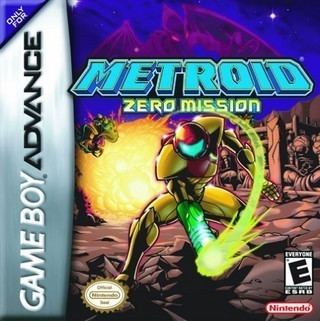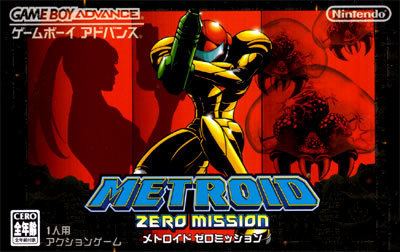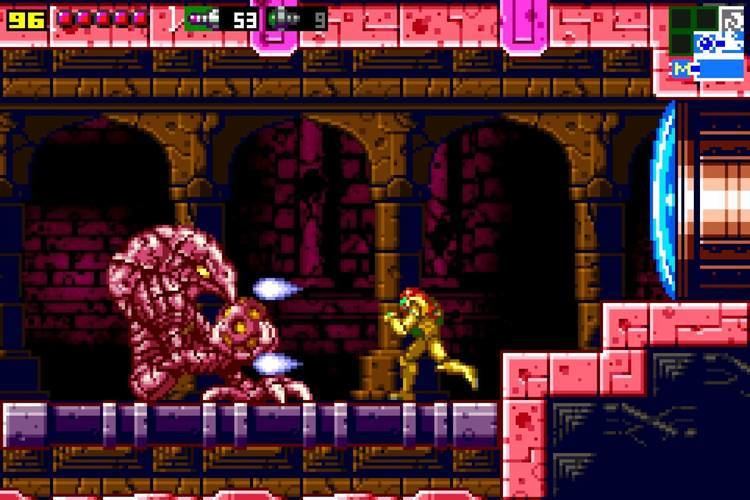9 /10 1 Votes9
9/10 IGN Producer(s) Takehiro Izushi Mode(s) Single-player | 4.7/5 Emuparadise 89% GameFAQs Initial release date 9 February 2004 | |||||||||||||||||||||||||||||||||
 | ||||||||||||||||||||||||||||||||||
Composer(s) Kenji YamamotoMinako Hamano Developer Nintendo Research & Development 1 Awards VGX Award for Best Handheld Game Similar Metroid games, Action-adventure games | ||||||||||||||||||||||||||||||||||
Metroid zero mission video walkthrough
Metroid: Zero Mission is an action-adventure video game published by Nintendo, and developed by its Research & Development 1 (R&D1) division for the Game Boy Advance. It is a remake of the 1986 game Metroid—the first installment in the Metroid video game series, and is designed to retell that entry's story with Super Metroid-like gameplay. It was released in North America in February 2004, with other territories later.
Contents
- Metroid zero mission video walkthrough
- Metroid zero mission gba hard mode 100 run full game
- Gameplay
- Plot
- Development
- Release
- Reception
- References

Like the other titles in the series, the player controls space-faring bounty hunter Samus Aran, who travels to planet Zebes after learning that Space Pirates are experimenting with Metroids in an attempt to duplicate them and use them for their own gain. The gameplay focuses on exploration, with the player searching for power-ups that are used to reach previously inaccessible areas. The remake also features new items, additional areas, mini-bosses, difficulty levels, and a rewritten story which explores Samus's backstory.

Reviews were generally positive towards the game. Praise focused on the new content, while criticism targeted the game's short length. Metroid: Zero Mission received several honors, including a 46th-place ranking in a list of the Top 200 Games compiled by Nintendo Power. It was also chosen as the 9th Best Game Boy Advance Game by IGN. The game has sold over 439,000 units in the United States and 69,000 in Japan as of February 2005. The Wii U's Virtual Console version was released in Japan on June 19, 2014; in Europe on March 12, 2015; and in North America on January 14, 2016.

Metroid zero mission gba hard mode 100 run full game
Gameplay
Metroid: Zero Mission takes place on Planet Zebes, a large, open-ended world with areas connected by doors and elevators. The player controls Samus Aran as she travels through the planet's caverns and environments, hunting Space Pirates. Along the way, the player collects power-ups that enhance Samus's armor and weaponry, as well as grant her special abilities. These abilities allow Samus to access areas that were previously inaccessible, so that the game can be played linearly or non-linearly. For example, the player may come across underground caverns that bypass certain sections, a method termed sequence breaking. To save their progress, players can enter either Save Rooms or Samus's ship on Crateria. As a remake of Metroid, Metroid: Zero Mission's layout bears a resemblance to the original, and various powerups and items make reappearances from previous games in the series, with similar uses, effects, and appearances. However, the game adds new items, areas, and mini-bosses, as well as a completely new area named Chozodia.
Zero Mission is the first game in the Metroid series to include a sequence in which the player controls Samus without her Power Suit. In this portion of the game, Samus is more vulnerable to damage, must crawl through ducts on her hands and knees without the help of her Morph Ball mode, and has a weak pistol that briefly stuns enemies as her only weapon. However, Samus retains all energy tanks she acquired previously.
Completion of the game unlocks an emulated version of the original Metroid game. Zero Mission also allow players to unlock the Metroid Fusion picture gallery by linking between Zero Mission and Fusion cartridges via the Game Boy Advance Game Link Cable.
Plot
Space Pirates attack a Galactic Federation-owned space research vessel and seize samples of Metroid creatures. Dangerous floating organisms, Metroids can latch on to any organism and drain its life energy to kill it. The Space Pirates plan to replicate Metroids by exposing them to beta rays and then using them as biological weapons to destroy all living beings that oppose them. While searching for the stolen Metroids, the Galactic Federation locates the Space Pirates' base of operations on the planet Zebes. The Federation assaults the planet, but the Pirates resist, forcing the Federation to retreat. As a last resort, the Federation decides to send a lone bounty hunter to penetrate the Pirates' base and destroy Mother Brain, the mechanical life-form that controls the Space Pirates' fortress and its defenses. Considered the greatest of all bounty hunters, Samus Aran is chosen for the mission.
Samus lands on the surface of Zebes and explores the planet, traveling through the planet's caverns. She eventually comes across Kraid, an ally of the Space Pirates, and Ridley, the Space Pirates' commander, and defeats them both. Along the way, Samus finds and destroys Mother Brain. However, while Samus leaves the planet in her gunship, it is attacked by Space Pirates, causing it to crash back onto Zebes, near the Space Pirate Mothership. Exploring the Mothership, Samus eventually reaches the Mecha Ridley, a mechanized form of Ridley. After defeating it, Samus escapes the planet using one of the Space Pirate's shuttles, while the Mothership self-destructs.
Development
Metroid: Zero Mission was directed by Yoshio Sakamoto, a Nintendo veteran who has been involved with the Metroid series since it first appeared on the Nintendo Entertainment System, and has played a role in every Metroid game except for Metroid II. Official positions that he held include director of Super Metroid for the Super Nintendo Entertainment System and Metroid Fusion for the Game Boy Advance, producer of Metroid Prime for the Nintendo GameCube, and supervisor of Metroid Prime 2: Echoes. Sakamoto is the only member from the Metroid development team to also work on Metroid: Zero Mission. Metroid: Zero Mission was the last game developed by Nintendo R&D1 before the team was disbanded due to Nintendo restructuring.
While working on the concept for the next Metroid game after Metroid Fusion was released in 2002, one of the developers for Metroid Fusion suggested that Super Metroid be ported to the Game Boy Advance; however, Sakamoto decided to port Metroid instead. The development team decided to return to the roots of Metroid gameplay by creating a game based on the original. Sakamoto, noting that Metroid Fusion's gameplay was drastically different from previous Metroid games, wanted to "show people who had never played a Metroid game prior to Metroid Fusion, the roots of the Metroid franchise, that this is what Metroid is, this is the style of gameplay that Metroid sprang from [...] at the same time, retell the story of Samus' original mission".
One of the biggest challenges that the developers faced was in adding enough elements to Metroid: Zero Mission to make it feel new, while keeping the spirit of the original Metroid. Because both games were made for the Game Boy Advance, Metroid: Zero Mission uses a rebuilt version of the game engine used for Metroid Fusion so that it did not need to be built from scratch. This marked the first time two Metroid installments have been released for the same video game console. Metroid Fusion had offered connectivity with Metroid Prime on the Nintendo GameCube, but Metroid: Zero Mission did not offer such a feature. Sakamoto explained that the developers wanted to make the game connect to Metroid Prime 2: Echoes on the GameCube, but the fact that both their release dates were far apart and not enough development time to implement connectivity features prevented them from doing so. However, they managed to include the ability for Metroid Fusion to connect with Metroid: Zero Mission.
In addition to borrowing the plot from Metroid, Metroid: Zero Mission introduces new cinematics to push the story forward. Sakamoto believed in the importance of having a story to complement a game. He found it particularly difficult to convey the game's plot accurately in a way that the player can understand, because of the sparse use of dialogue in the Metroid series. The story for Metroid: Zero Mission was rewritten to explore Samus Aran's backstory more than in the original Metroid. Cinematics are used to show Samus' memories to move the story forward and to keep the plot open for interpretation. Sakamoto claimed that this was intended to expand the original story while retaining some mystery. The game is the first Metroid game to let the player choose a difficulty level at the start of the game; each of three levels varies in the amount of damage caused by enemies. The battle with Mother Brain marked the end of the original Metroid; however, Metroid: Zero Mission offers players extra levels to play after the battle.
Release
Nintendo first revealed Metroid: Zero Mission at the E3 convention in 2003, and its North American release date of February 9, 2004 was announced later that year. In other territories, Zero Mission was released in Australia on March 19, 2004, in Europe on April 8, and in Japan on May 27. The Wii U's Virtual Console version of Zero Mission was released in Japan on June 19, 2014. This was followed by the release in Europe on March 12, 2015, and in North America on January 14, 2016.
Reception
Metroid: Zero Mission was given "generally favorable reviews", according to Metacritic. The game was praised by a number of reviews, several which called it one of the best games available for the Game Boy Advance. X-Play and GamePro enjoyed the game; X-Play said the game was "perfect for blasting space pirates on the go", and GamePro was "constantly surprised" with what the game offered. GameZone found it "hard to imagine a Game Boy Advance game that could match the style and addictive action of 'Metroid Fusion'", but admitted that Metroid: Zero Mission surpasses the game quite easily. Agreeing with GameZone, Nintendo World Report called the game a masterpiece and the perfect example of how a Metroid game should be done: "The designers carefully mix all the best elements from the other games and layer them on top of the already brilliant level design and concepts of the original Metroid." Eurogamer appreciated every minute of the game, affirming that Metroid: Zero Mission should be considered one of the best games available for the Game Boy Advance.
A number of reviews were pleased with the new content added to Metroid: Zero Mission. Game Informer appreciated the new material, and believed that fans of the Metroid series would "absolutely adore" Metroid: Zero Mission, which they considered one of the greatest video games in the history of gaming. 1UP.com considered Metroid: Zero Mission to be one of the "most ambitious, comprehensive and successful" remakes for a game such as Metroid, noting that "[Metroid: Zero Mission] expands on its source material with refined control, gameplay ideas retrofitted from its sequels, new plot hooks for subsequent chapters of the saga, and some jaw-droppingly cool innovations which add new layers of complexity to the series."
Criticism of the game stemmed from its short length. Regarded as a "weak one-shot experience", IGN felt that players would enjoy the game only after they had completed it and played it again Eurogamer stated simply: "We can't help but wish that it had been longer." Even though GamesRadar liked the game's quality, they said that Nintendo should have "[made] the experience last longer." GameSpot was disappointed with the "short-lived experience", but blamed the game's captivating quality that compelled them to complete the game in a few sittings. Calling Metroid: Zero Mission stale, GameSpy asserted that players less familiar with Metroid games would get more enjoyment out of it because of its similarities to previous Metroid games.
Metroid: Zero Mission was ranked the best-selling Game Boy Advance game in the United States in its debut month of February 2004, selling 151,807 units, and it was the 3rd best-selling game across all video game systems in that month. In May 2004, the game's sales dropped to 7th among Game Boy Advance games, with 31,619 copies sold and $938,681 in revenue. By February 2005, the game had sold over 439,000 units in the United States and 69,000 in Japan. The game was ranked the 46th-best game for any Nintendo system in Nintendo Power's Top 200 Games list. In their March 2010 issue, the magazine also ranked Metroid: Zero Mission as the eighth-best game to be released on a Nintendo console in the 2000 decade, in their "Best of the Decade" feature. Metroid: Zero Mission was voted IGN's Game Boy Advance Game of the Month for February 2004, and the website's staff picked the game as both the Best Game Boy Adventure Game of 2004, and the 9th Best Game Boy Advance Game. Electronic Gaming Monthly also picked it as the Best Handheld Game of 2004. Official Nintendo Magazine ranked the game 94th in a list of the best Nintendo games. Nintendo Power also ranked it the best Game Boy Advance game of all-time in its August 2011 issue.
